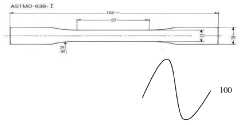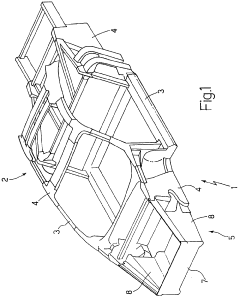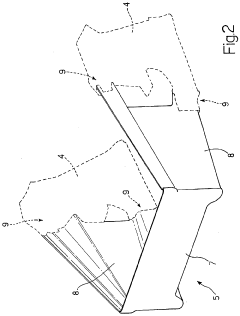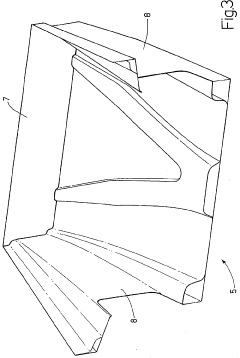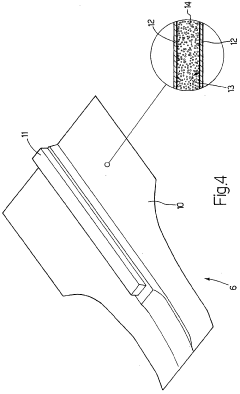How to Innovate Car Interiors with Kevlar Composite Technologies?
JUL 10, 20259 MIN READ
Generate Your Research Report Instantly with AI Agent
Patsnap Eureka helps you evaluate technical feasibility & market potential.
Kevlar Composite Evolution in Automotive Interiors
The evolution of Kevlar composite technologies in automotive interiors represents a significant shift in the approach to vehicle design and manufacturing. Kevlar, a high-strength synthetic fiber developed by DuPont in the 1960s, has traditionally been associated with applications in aerospace, military, and protective equipment. However, its unique properties have increasingly found relevance in the automotive sector, particularly in interior components.
In the early stages of its automotive application, Kevlar was primarily used for exterior components due to its high strength-to-weight ratio and impact resistance. The transition to interior applications began in the late 1990s, as automakers sought innovative materials to enhance vehicle performance while reducing weight. This shift was driven by the growing emphasis on fuel efficiency and the need to meet stringent emissions regulations.
The first notable applications of Kevlar composites in car interiors were in structural components such as door panels and seat frames. These early adoptions demonstrated the material's potential to significantly reduce vehicle weight without compromising safety or structural integrity. As manufacturing techniques advanced, Kevlar composites began to be incorporated into more visible and tactile interior elements.
By the mid-2000s, luxury and high-performance vehicle manufacturers started experimenting with Kevlar-reinforced interior trim pieces, leveraging the material's unique aesthetic properties alongside its functional benefits. This period saw the development of new composite formulations that combined Kevlar with other materials like carbon fiber and thermoplastics, creating hybrid composites that offered enhanced performance characteristics.
The 2010s marked a turning point in the widespread adoption of Kevlar composites in automotive interiors. Advancements in manufacturing processes, particularly in the areas of molding and bonding, allowed for more complex and intricate interior designs. This era saw the introduction of Kevlar-enhanced dashboards, center consoles, and even steering wheels in high-end vehicles.
Recent years have witnessed a focus on sustainability and recyclability in automotive design, prompting further innovation in Kevlar composite technologies. Researchers and manufacturers have been developing bio-based precursors for Kevlar and exploring ways to incorporate recycled Kevlar fibers into new composite materials. These efforts align with the automotive industry's broader push towards more environmentally friendly practices.
Looking ahead, the evolution of Kevlar composites in automotive interiors is likely to continue, driven by advancements in nanotechnology and smart materials. The integration of Kevlar with electronic components and sensors points towards a future where interior surfaces could serve multiple functions, from structural support to interactive interfaces. As the automotive industry moves towards electric and autonomous vehicles, the role of Kevlar composites in creating lightweight, durable, and multifunctional interiors is expected to expand further.
In the early stages of its automotive application, Kevlar was primarily used for exterior components due to its high strength-to-weight ratio and impact resistance. The transition to interior applications began in the late 1990s, as automakers sought innovative materials to enhance vehicle performance while reducing weight. This shift was driven by the growing emphasis on fuel efficiency and the need to meet stringent emissions regulations.
The first notable applications of Kevlar composites in car interiors were in structural components such as door panels and seat frames. These early adoptions demonstrated the material's potential to significantly reduce vehicle weight without compromising safety or structural integrity. As manufacturing techniques advanced, Kevlar composites began to be incorporated into more visible and tactile interior elements.
By the mid-2000s, luxury and high-performance vehicle manufacturers started experimenting with Kevlar-reinforced interior trim pieces, leveraging the material's unique aesthetic properties alongside its functional benefits. This period saw the development of new composite formulations that combined Kevlar with other materials like carbon fiber and thermoplastics, creating hybrid composites that offered enhanced performance characteristics.
The 2010s marked a turning point in the widespread adoption of Kevlar composites in automotive interiors. Advancements in manufacturing processes, particularly in the areas of molding and bonding, allowed for more complex and intricate interior designs. This era saw the introduction of Kevlar-enhanced dashboards, center consoles, and even steering wheels in high-end vehicles.
Recent years have witnessed a focus on sustainability and recyclability in automotive design, prompting further innovation in Kevlar composite technologies. Researchers and manufacturers have been developing bio-based precursors for Kevlar and exploring ways to incorporate recycled Kevlar fibers into new composite materials. These efforts align with the automotive industry's broader push towards more environmentally friendly practices.
Looking ahead, the evolution of Kevlar composites in automotive interiors is likely to continue, driven by advancements in nanotechnology and smart materials. The integration of Kevlar with electronic components and sensors points towards a future where interior surfaces could serve multiple functions, from structural support to interactive interfaces. As the automotive industry moves towards electric and autonomous vehicles, the role of Kevlar composites in creating lightweight, durable, and multifunctional interiors is expected to expand further.
Market Demand for Lightweight Car Interiors
The automotive industry is witnessing a significant shift towards lightweight car interiors, driven by the increasing demand for fuel efficiency, improved performance, and enhanced sustainability. This trend has created a substantial market opportunity for innovative materials like Kevlar composites in car interior applications. The global automotive interior market is projected to grow steadily, with a particular emphasis on lightweight solutions.
Consumer preferences are evolving, with a growing focus on comfort, aesthetics, and environmental consciousness. Lightweight interiors contribute to overall vehicle weight reduction, directly impacting fuel consumption and emissions. This aligns with stringent government regulations on fuel efficiency and carbon emissions, pushing automakers to explore advanced materials for interior components.
Kevlar composite technologies offer a unique combination of strength, durability, and lightweight properties, making them ideal for various car interior applications. The market demand for Kevlar-based interior solutions is particularly strong in premium and luxury vehicle segments, where customers are willing to pay a premium for high-performance materials and innovative designs.
The automotive industry's shift towards electric and autonomous vehicles is further amplifying the need for lightweight interiors. As these vehicles require heavy battery packs, reducing weight in other areas becomes crucial to maintain overall performance and range. Kevlar composites can play a significant role in this weight reduction strategy, especially in structural components of the interior.
There is also a growing demand for customization and personalization in car interiors. Kevlar composites offer design flexibility and can be engineered to meet specific aesthetic and functional requirements, catering to this trend. The material's ability to be molded into complex shapes while maintaining its strength properties opens up new possibilities for innovative interior designs.
Safety considerations are driving demand for advanced materials in car interiors as well. Kevlar's high strength-to-weight ratio and impact resistance make it an attractive option for safety-critical interior components, aligning with the increasing focus on passenger safety in the automotive industry.
The market for sustainable materials in car interiors is expanding rapidly. Kevlar composites, when combined with bio-based resins or recycled materials, can meet the growing demand for eco-friendly interior solutions. This aspect is particularly important for automakers looking to improve their environmental credentials and appeal to environmentally conscious consumers.
Consumer preferences are evolving, with a growing focus on comfort, aesthetics, and environmental consciousness. Lightweight interiors contribute to overall vehicle weight reduction, directly impacting fuel consumption and emissions. This aligns with stringent government regulations on fuel efficiency and carbon emissions, pushing automakers to explore advanced materials for interior components.
Kevlar composite technologies offer a unique combination of strength, durability, and lightweight properties, making them ideal for various car interior applications. The market demand for Kevlar-based interior solutions is particularly strong in premium and luxury vehicle segments, where customers are willing to pay a premium for high-performance materials and innovative designs.
The automotive industry's shift towards electric and autonomous vehicles is further amplifying the need for lightweight interiors. As these vehicles require heavy battery packs, reducing weight in other areas becomes crucial to maintain overall performance and range. Kevlar composites can play a significant role in this weight reduction strategy, especially in structural components of the interior.
There is also a growing demand for customization and personalization in car interiors. Kevlar composites offer design flexibility and can be engineered to meet specific aesthetic and functional requirements, catering to this trend. The material's ability to be molded into complex shapes while maintaining its strength properties opens up new possibilities for innovative interior designs.
Safety considerations are driving demand for advanced materials in car interiors as well. Kevlar's high strength-to-weight ratio and impact resistance make it an attractive option for safety-critical interior components, aligning with the increasing focus on passenger safety in the automotive industry.
The market for sustainable materials in car interiors is expanding rapidly. Kevlar composites, when combined with bio-based resins or recycled materials, can meet the growing demand for eco-friendly interior solutions. This aspect is particularly important for automakers looking to improve their environmental credentials and appeal to environmentally conscious consumers.
Current Challenges in Kevlar Composite Integration
The integration of Kevlar composite technologies into car interiors presents several significant challenges that manufacturers and engineers must overcome. One of the primary obstacles is the high cost associated with Kevlar production and processing. The material's complex manufacturing process and the need for specialized equipment contribute to its premium price point, making it challenging to implement on a large scale in mass-produced vehicles.
Another hurdle is the difficulty in molding and shaping Kevlar composites to fit the intricate designs of car interiors. Unlike traditional materials such as plastics or metals, Kevlar composites require specific techniques and expertise to form them into complex shapes while maintaining their structural integrity and performance characteristics. This limitation can restrict design flexibility and increase production complexity.
Durability and wear resistance in high-traffic areas of the car interior pose additional challenges. While Kevlar is known for its strength, its performance under constant abrasion and exposure to UV light in a vehicle environment needs further investigation and improvement. Ensuring that Kevlar-based interior components maintain their appearance and functionality over the vehicle's lifetime is crucial for customer satisfaction and long-term viability.
Weight reduction, a key driver for using composites in automotive applications, presents a paradox when it comes to Kevlar. Although Kevlar is lighter than many traditional materials, achieving significant weight savings while maintaining the necessary structural properties for interior components can be challenging. Balancing weight reduction with performance and safety requirements demands innovative engineering solutions.
The integration of Kevlar composites with other materials commonly used in car interiors, such as fabrics, leathers, and electronics, presents compatibility issues. Developing effective bonding and joining techniques that ensure long-term durability and aesthetics is essential. Additionally, the potential for galvanic corrosion when Kevlar composites come into contact with metal components must be addressed.
Fire safety and toxicity concerns are also significant challenges. While Kevlar itself has good flame-resistant properties, the resins and additives used in composite formulations may not meet stringent automotive fire safety standards. Developing Kevlar composite systems that comply with these regulations without compromising performance or increasing costs is a complex task.
Lastly, the automotive industry's push towards sustainability and recyclability poses a challenge for Kevlar composite integration. The current limitations in recycling and disposing of Kevlar composites at the end of a vehicle's life cycle conflict with increasing environmental regulations and consumer expectations for eco-friendly products. Developing effective recycling methods or creating biodegradable Kevlar-based composites remains an area requiring significant research and development efforts.
Another hurdle is the difficulty in molding and shaping Kevlar composites to fit the intricate designs of car interiors. Unlike traditional materials such as plastics or metals, Kevlar composites require specific techniques and expertise to form them into complex shapes while maintaining their structural integrity and performance characteristics. This limitation can restrict design flexibility and increase production complexity.
Durability and wear resistance in high-traffic areas of the car interior pose additional challenges. While Kevlar is known for its strength, its performance under constant abrasion and exposure to UV light in a vehicle environment needs further investigation and improvement. Ensuring that Kevlar-based interior components maintain their appearance and functionality over the vehicle's lifetime is crucial for customer satisfaction and long-term viability.
Weight reduction, a key driver for using composites in automotive applications, presents a paradox when it comes to Kevlar. Although Kevlar is lighter than many traditional materials, achieving significant weight savings while maintaining the necessary structural properties for interior components can be challenging. Balancing weight reduction with performance and safety requirements demands innovative engineering solutions.
The integration of Kevlar composites with other materials commonly used in car interiors, such as fabrics, leathers, and electronics, presents compatibility issues. Developing effective bonding and joining techniques that ensure long-term durability and aesthetics is essential. Additionally, the potential for galvanic corrosion when Kevlar composites come into contact with metal components must be addressed.
Fire safety and toxicity concerns are also significant challenges. While Kevlar itself has good flame-resistant properties, the resins and additives used in composite formulations may not meet stringent automotive fire safety standards. Developing Kevlar composite systems that comply with these regulations without compromising performance or increasing costs is a complex task.
Lastly, the automotive industry's push towards sustainability and recyclability poses a challenge for Kevlar composite integration. The current limitations in recycling and disposing of Kevlar composites at the end of a vehicle's life cycle conflict with increasing environmental regulations and consumer expectations for eco-friendly products. Developing effective recycling methods or creating biodegradable Kevlar-based composites remains an area requiring significant research and development efforts.
Existing Kevlar Composite Interior Solutions
01 Kevlar composite manufacturing techniques
Various manufacturing techniques are employed to create Kevlar composites, including molding, lamination, and advanced fiber placement methods. These processes aim to optimize the strength-to-weight ratio and enhance the overall performance of the composite materials.- Kevlar composite manufacturing techniques: Advanced manufacturing techniques for Kevlar composites, including innovative layering methods, resin infusion processes, and specialized curing techniques to enhance the material's strength and durability. These methods aim to optimize the integration of Kevlar fibers with various matrix materials, resulting in improved mechanical properties and performance characteristics of the final composite.
- Kevlar-reinforced polymer composites: Development of polymer composites reinforced with Kevlar fibers, focusing on enhancing the mechanical properties, impact resistance, and lightweight characteristics of the resulting materials. These composites often combine Kevlar with other polymers or additives to create hybrid materials with tailored properties for specific applications in aerospace, automotive, and protective equipment industries.
- Kevlar-based nanocomposites: Incorporation of nanoparticles or nanostructures into Kevlar-based composites to enhance their properties at the nanoscale. This includes the use of carbon nanotubes, graphene, or other nanomaterials to improve the strength, thermal conductivity, and electrical properties of Kevlar composites, opening up new applications in electronics and smart materials.
- Kevlar composite coatings and surface treatments: Development of specialized coatings and surface treatments for Kevlar composites to enhance their resistance to environmental factors, improve adhesion properties, and add functionalities such as self-healing or self-cleaning capabilities. These technologies aim to extend the lifespan and performance of Kevlar-based products in challenging environments.
- Kevlar hybrid composites: Creation of hybrid composites that combine Kevlar with other high-performance fibers or materials, such as carbon fiber, glass fiber, or natural fibers. These hybrid composites aim to leverage the unique properties of each component, resulting in materials with enhanced strength-to-weight ratios, improved impact resistance, and better overall performance for specific applications.
02 Kevlar-reinforced polymer composites
Kevlar fibers are incorporated into polymer matrices to create high-performance composites. These materials exhibit improved mechanical properties, such as increased tensile strength, impact resistance, and durability, making them suitable for various applications in aerospace, automotive, and defense industries.Expand Specific Solutions03 Kevlar hybrid composites
Hybrid composites combining Kevlar with other materials like carbon fiber, glass fiber, or natural fibers are developed to achieve synergistic properties. These hybrid composites offer a balance of strength, stiffness, and impact resistance, tailored for specific applications.Expand Specific Solutions04 Surface treatment and functionalization of Kevlar fibers
Various surface treatment and functionalization techniques are applied to Kevlar fibers to improve their adhesion to matrix materials and enhance the overall performance of the composites. These methods include chemical treatments, plasma treatments, and nanoparticle coatings.Expand Specific Solutions05 Kevlar composite applications in protective equipment
Kevlar composites are extensively used in the development of protective equipment such as body armor, helmets, and blast-resistant structures. The unique properties of Kevlar, including high strength and low weight, make it ideal for these applications, providing enhanced protection against ballistic threats and impacts.Expand Specific Solutions
Key Players in Automotive Kevlar Composites
The automotive interior innovation landscape using Kevlar composite technologies is in a growth phase, with increasing market size and evolving technical maturity. Major players like Ford Global Technologies, BMW, and Hyundai Motor Co. are investing in research and development to leverage Kevlar's lightweight and high-strength properties for interior components. The market is seeing a shift towards sustainable and high-performance materials, with companies like SABIC Global Technologies and Milliken & Co. developing advanced composite solutions. Emerging players such as Yanfeng GLOBAL AUTOMOTIVE Interior SYSTEMS and Faurecia Innenraum Systeme are also contributing to the competitive landscape, focusing on integrating Kevlar composites into innovative interior designs for improved safety, aesthetics, and functionality.
Ford Global Technologies LLC
Technical Solution: Ford has developed an innovative approach to integrating Kevlar composite technologies into car interiors. They have created a lightweight, high-strength material by combining Kevlar fibers with recycled plastics[1]. This composite is used in various interior components, including door panels, center consoles, and seat backs. The material offers a 25% weight reduction compared to traditional materials while maintaining superior strength and durability[2]. Ford's process involves a proprietary molding technique that allows for complex shapes and textures, enhancing both aesthetics and functionality. Additionally, they have implemented a nano-coating technology that makes the Kevlar-based surfaces resistant to stains and UV radiation, increasing longevity and reducing maintenance needs[3].
Strengths: Significant weight reduction, improved durability, and enhanced sustainability through the use of recycled materials. Weaknesses: Potentially higher production costs and the need for specialized manufacturing processes.
Ferrari SpA
Technical Solution: Ferrari has taken a unique approach to incorporating Kevlar composite technologies in their high-performance car interiors. Their focus is on creating ultra-lightweight, high-strength components that enhance both performance and luxury. Ferrari's innovation lies in their "Kevlar-Carbon Hybrid" material, which combines Kevlar fibers with carbon nanotubes[8]. This advanced composite is used in structural elements of the interior, such as the central tunnel, dashboard structure, and seat frames. The material offers an unprecedented strength-to-weight ratio, allowing for a 40% weight reduction compared to traditional materials used in these applications[9]. Ferrari has also developed a proprietary finishing process that allows this high-tech material to be seamlessly integrated with premium leather and other luxury materials, maintaining the brand's signature aesthetic.
Strengths: Exceptional weight reduction, integration of cutting-edge materials science, and maintenance of luxury aesthetics. Weaknesses: Extremely high production costs and limited applicability to mass-market vehicles.
Innovative Kevlar Composite Applications
Method to develop kevlar aluminium embedded reinforced composite material
PatentPendingIN202141050694A
Innovation
- A Kevlar aluminium embedded reinforced composite material is developed using the hand lay-up method with a 0°-90° orientation of Kevlar fibre layers and epoxy resin, incorporating embedded sensors for environmental monitoring and adjustments, and a resin-hardener mixture ratio of 10:1, which is applied to replace metal and alloy products in luxury car components.
Car frame featuring RTM-technology modules of composite material
PatentWO2006011057A1
Innovation
- A car frame design combining an aluminum central body with bolted composite material RTM (Resin Transfer Molding) technology front and floor panels, allowing for easier production and modular assembly, using carbon, Kevlar, or glass fibers to balance cost and structural performance.
Environmental Impact of Kevlar Composites
The integration of Kevlar composite technologies in car interiors presents both opportunities and challenges from an environmental perspective. Kevlar, a high-strength synthetic fiber, offers significant weight reduction potential in automotive applications, which can lead to improved fuel efficiency and reduced emissions over the vehicle's lifetime. This aligns with the automotive industry's push towards more sustainable transportation solutions.
However, the production of Kevlar composites involves energy-intensive processes and the use of petrochemical-based materials, which can contribute to carbon emissions and resource depletion. The manufacturing process requires careful consideration to minimize environmental impact, including optimizing energy consumption and exploring renewable energy sources for production facilities.
One of the key environmental benefits of Kevlar composites in car interiors is their durability and resistance to wear and tear. This longevity can reduce the need for frequent replacements, potentially decreasing the overall environmental footprint associated with manufacturing and disposing of interior components. Additionally, the lightweight nature of Kevlar composites can contribute to overall vehicle weight reduction, leading to improved fuel economy and reduced greenhouse gas emissions during the car's operational life.
Recycling and end-of-life management of Kevlar composite components pose significant challenges. Unlike traditional materials used in car interiors, Kevlar composites are not easily recyclable through conventional methods. This necessitates the development of specialized recycling technologies and processes to ensure that these materials do not end up in landfills at the end of their useful life.
Research into bio-based alternatives and sustainable production methods for Kevlar composites is ongoing. These efforts aim to reduce the reliance on petroleum-based raw materials and minimize the environmental impact of production processes. Innovations in this area could potentially lead to more environmentally friendly Kevlar composite solutions for car interiors in the future.
The automotive industry's adoption of Kevlar composites must be balanced with a comprehensive life cycle assessment to fully understand and mitigate environmental impacts. This includes considering factors such as raw material sourcing, production energy requirements, transportation, use-phase benefits, and end-of-life management. By taking a holistic approach, manufacturers can make informed decisions about the integration of Kevlar composites in car interiors while minimizing negative environmental consequences.
However, the production of Kevlar composites involves energy-intensive processes and the use of petrochemical-based materials, which can contribute to carbon emissions and resource depletion. The manufacturing process requires careful consideration to minimize environmental impact, including optimizing energy consumption and exploring renewable energy sources for production facilities.
One of the key environmental benefits of Kevlar composites in car interiors is their durability and resistance to wear and tear. This longevity can reduce the need for frequent replacements, potentially decreasing the overall environmental footprint associated with manufacturing and disposing of interior components. Additionally, the lightweight nature of Kevlar composites can contribute to overall vehicle weight reduction, leading to improved fuel economy and reduced greenhouse gas emissions during the car's operational life.
Recycling and end-of-life management of Kevlar composite components pose significant challenges. Unlike traditional materials used in car interiors, Kevlar composites are not easily recyclable through conventional methods. This necessitates the development of specialized recycling technologies and processes to ensure that these materials do not end up in landfills at the end of their useful life.
Research into bio-based alternatives and sustainable production methods for Kevlar composites is ongoing. These efforts aim to reduce the reliance on petroleum-based raw materials and minimize the environmental impact of production processes. Innovations in this area could potentially lead to more environmentally friendly Kevlar composite solutions for car interiors in the future.
The automotive industry's adoption of Kevlar composites must be balanced with a comprehensive life cycle assessment to fully understand and mitigate environmental impacts. This includes considering factors such as raw material sourcing, production energy requirements, transportation, use-phase benefits, and end-of-life management. By taking a holistic approach, manufacturers can make informed decisions about the integration of Kevlar composites in car interiors while minimizing negative environmental consequences.
Safety Regulations for Composite Interiors
The integration of Kevlar composite technologies in car interiors necessitates a thorough understanding and adherence to safety regulations. These regulations are designed to ensure that the use of composite materials does not compromise the safety of vehicle occupants. The Federal Motor Vehicle Safety Standards (FMVSS) in the United States and the United Nations Economic Commission for Europe (UNECE) regulations in Europe are the primary governing bodies for automotive safety standards.
For composite interiors, FMVSS 302 is particularly relevant, as it sets the flammability requirements for materials used in the occupant compartments of motor vehicles. Kevlar composites must meet or exceed these standards, demonstrating a burn rate below 102 mm per minute. Additionally, FMVSS 201 addresses occupant protection in interior impact, requiring that composite materials used in car interiors provide adequate energy absorption during collisions.
The use of Kevlar composites in car interiors must also comply with regulations concerning toxic fume emissions in case of fire. The ISO 3795 standard, which is harmonized with FMVSS 302, provides a method for determining the burning behavior of interior materials. Manufacturers must ensure that Kevlar composite components do not release harmful substances when exposed to high temperatures or flames.
Crashworthiness is another critical aspect of safety regulations for composite interiors. The IIHS (Insurance Institute for Highway Safety) and Euro NCAP (European New Car Assessment Programme) conduct rigorous crash tests that evaluate the performance of interior materials during impacts. Kevlar composites used in structural components or safety-critical areas must demonstrate their ability to maintain integrity and protect occupants during these tests.
Regulations also address the potential for sharp edges or fragmentation in the event of a crash. UNECE Regulation No. 21 specifies requirements for the interior fittings of vehicles, including the behavior of materials under impact. Kevlar composites must be designed and tested to ensure they do not create hazardous projections or edges that could injure occupants during a collision.
As environmental concerns grow, regulations are evolving to include the recyclability and end-of-life disposal of automotive materials. The European Union's End-of-Life Vehicles Directive (2000/53/EC) mandates that 95% of a vehicle by weight must be reusable or recyclable. This directive impacts the design and selection of composite materials, requiring manufacturers to consider the entire lifecycle of Kevlar composite components used in car interiors.
For composite interiors, FMVSS 302 is particularly relevant, as it sets the flammability requirements for materials used in the occupant compartments of motor vehicles. Kevlar composites must meet or exceed these standards, demonstrating a burn rate below 102 mm per minute. Additionally, FMVSS 201 addresses occupant protection in interior impact, requiring that composite materials used in car interiors provide adequate energy absorption during collisions.
The use of Kevlar composites in car interiors must also comply with regulations concerning toxic fume emissions in case of fire. The ISO 3795 standard, which is harmonized with FMVSS 302, provides a method for determining the burning behavior of interior materials. Manufacturers must ensure that Kevlar composite components do not release harmful substances when exposed to high temperatures or flames.
Crashworthiness is another critical aspect of safety regulations for composite interiors. The IIHS (Insurance Institute for Highway Safety) and Euro NCAP (European New Car Assessment Programme) conduct rigorous crash tests that evaluate the performance of interior materials during impacts. Kevlar composites used in structural components or safety-critical areas must demonstrate their ability to maintain integrity and protect occupants during these tests.
Regulations also address the potential for sharp edges or fragmentation in the event of a crash. UNECE Regulation No. 21 specifies requirements for the interior fittings of vehicles, including the behavior of materials under impact. Kevlar composites must be designed and tested to ensure they do not create hazardous projections or edges that could injure occupants during a collision.
As environmental concerns grow, regulations are evolving to include the recyclability and end-of-life disposal of automotive materials. The European Union's End-of-Life Vehicles Directive (2000/53/EC) mandates that 95% of a vehicle by weight must be reusable or recyclable. This directive impacts the design and selection of composite materials, requiring manufacturers to consider the entire lifecycle of Kevlar composite components used in car interiors.
Unlock deeper insights with Patsnap Eureka Quick Research — get a full tech report to explore trends and direct your research. Try now!
Generate Your Research Report Instantly with AI Agent
Supercharge your innovation with Patsnap Eureka AI Agent Platform!
